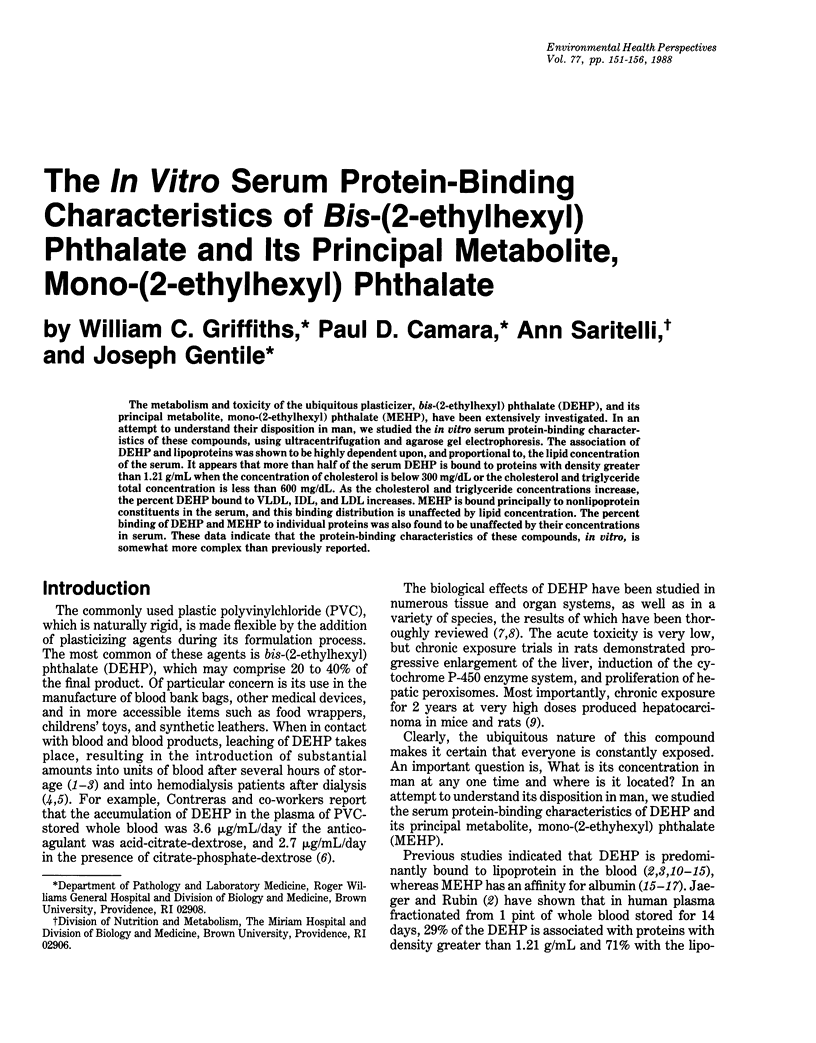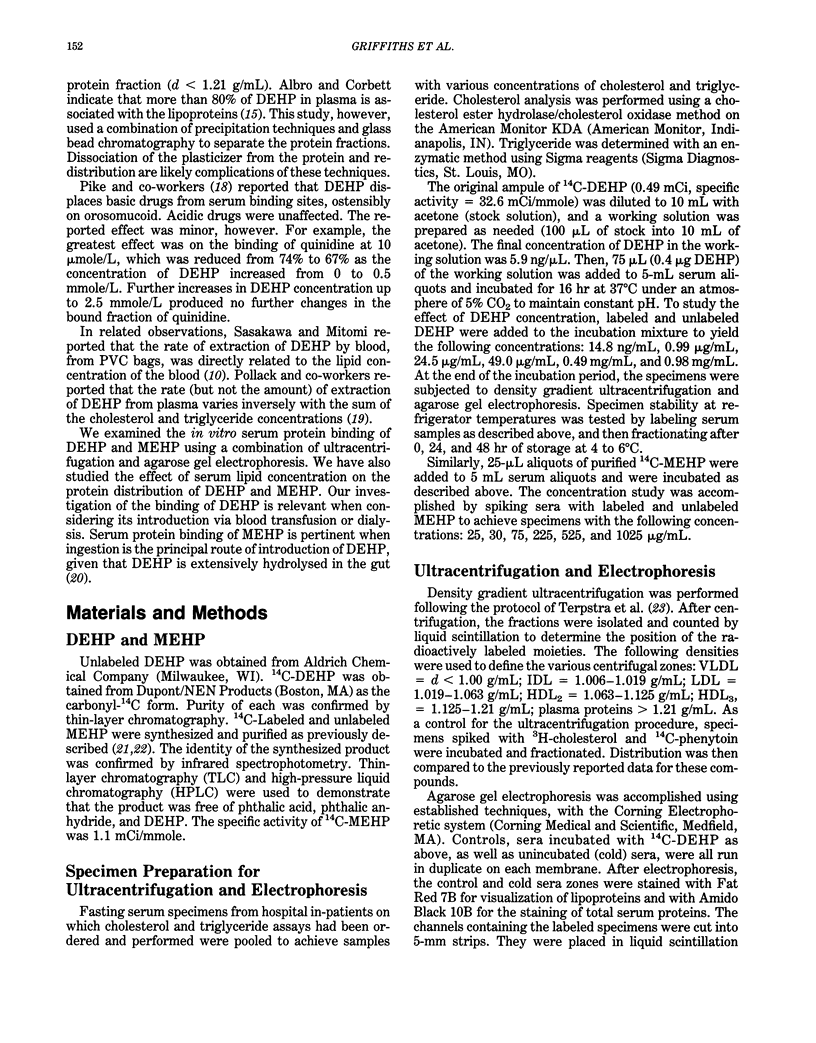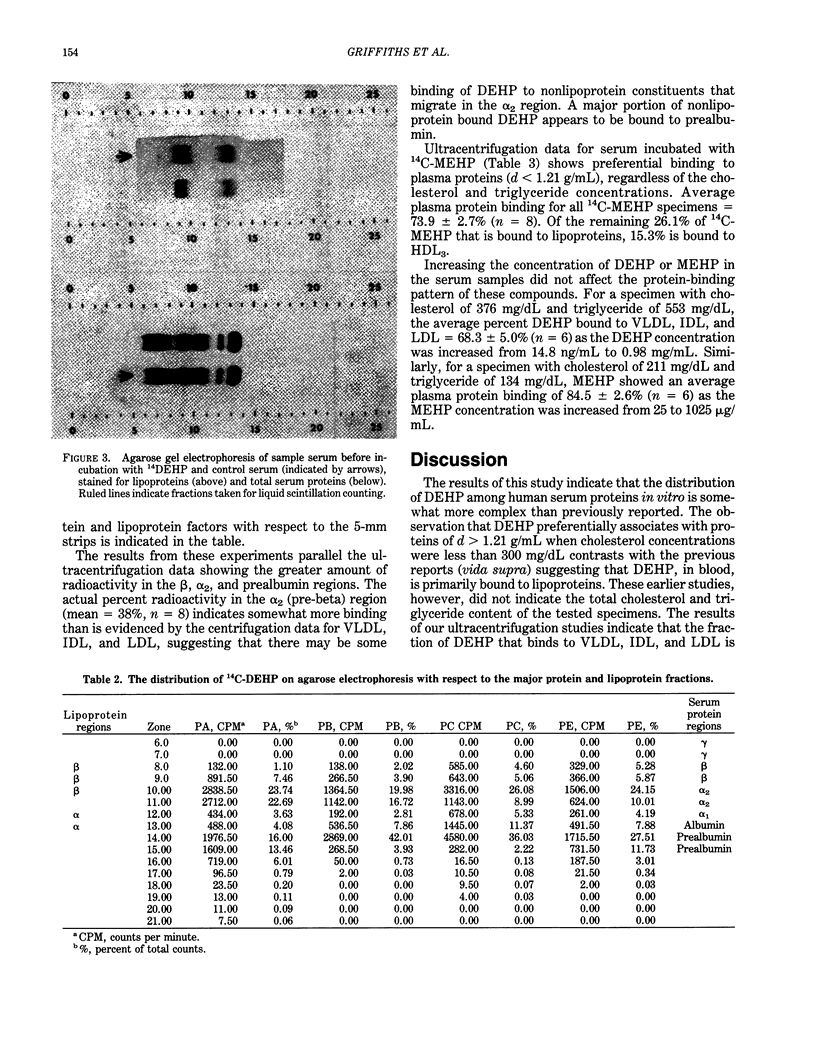Abstract
The metabolism and toxicity of the ubiquitous plasticizer, bis-(2-ethylhexyl) phthalate (DEHP), and its principal metabolite, mono-(2-ethylhexyl) phthalate (MEHP), have been extensively investigated. In an attempt to understand their disposition in man, we studied the in vitro serum protein-binding characteristics of these compounds, using ultracentrifugation and agarose gel electrophoresis. The association of DEHP and lipoproteins was shown to be highly dependent upon, and proportional to, the lipid concentration of the serum. It appears that more than half of the serum DEHP is bound to proteins with density greater than 1.21 g/mL when the concentration of cholesterol is below 300 mg/dL or the cholesterol and triglyceride total concentration is less than 600 mg/dL. As the cholesterol and triglyceride concentrations increase, the percent DEHP bound to VLDL, IDL, and LDL increases. MEHP is bound principally to nonlipoprotein constituents in the serum, and this binding distribution is unaffected by lipid concentration. The percent binding of DEHP and MEHP to individual proteins was also found to be unaffected by their concentrations in serum. These data indicate that the protein-binding characteristics of these compounds, in vitro, is somewhat more complex than previously reported.
Full text
PDF





Images in this article
Selected References
These references are in PubMed. This may not be the complete list of references from this article.
- Albro P. W., Corbett J. T. Distribution of di- and mono-(2-ethylhexyl) phthalate in human plasma. Transfusion. 1978 Nov-Dec;18(6):750–755. doi: 10.1046/j.1537-2995.1978.18679077962.x. [DOI] [PubMed] [Google Scholar]
- Albro P. W., Thomas R. O. Enzymatic hydrolysis of di-(2-ethylhexyl) phthalate by lipases. Biochim Biophys Acta. 1973 Jun 21;306(3):380–390. doi: 10.1016/0005-2760(73)90176-8. [DOI] [PubMed] [Google Scholar]
- Albro P. W., Thomas R., Fishbein L. Metabolism of diethylhexyl phthalate by rats. Isolation and characterization of the urinary metabolites. J Chromatogr. 1973 Feb 28;76(2):321–330. doi: 10.1016/s0021-9673(01)96915-8. [DOI] [PubMed] [Google Scholar]
- Cole R. S., Tocchi M., Wye E., Villeneuve D. C., Rock G. Contamination of commercial blood products by di-2-ethylhexyl phthalate and mono-2-ethylhexyl phthalate. Vox Sang. 1981 May;40(5):317–322. doi: 10.1111/j.1423-0410.1981.tb00715.x. [DOI] [PubMed] [Google Scholar]
- Contreras T. J., Sheibley R. H., Valeri C. R. Accumulation of DI-2-ethylhexyl phthalate (DEHP) in whole blood, platelet concentrates, and platelet-poor plasma. Transfusion. 1974 Jan-Feb;14(1):34–46. doi: 10.1111/j.1537-2995.1974.tb04481.x. [DOI] [PubMed] [Google Scholar]
- Gibson T. P., Briggs W. A., Boone B. J. Delivery of di-2-ethylhexyl phthalate to patients during hemodialysis. J Lab Clin Med. 1976 Mar;87(3):519–524. [PubMed] [Google Scholar]
- Griffiths W. C., Camara P., Lerner K. S. Bis-(2-ethylhexyl) phthalate, an ubiquitous environmental contaminant. Ann Clin Lab Sci. 1985 Mar-Apr;15(2):140–151. [PubMed] [Google Scholar]
- Jaeger R. J., Rubin R. J. Contamination of blood stored in plastic packs. Lancet. 1970 Jul 18;2(7664):151–151. doi: 10.1016/s0140-6736(70)92734-0. [DOI] [PubMed] [Google Scholar]
- Jaeger R. J., Rubin R. J. Migration of a phthalate ester plasticizer from polyvinyl chloride blood bags into stored human blood and its localization in human tissues. N Engl J Med. 1972 Nov 30;287(22):1114–1118. doi: 10.1056/NEJM197211302872203. [DOI] [PubMed] [Google Scholar]
- Jaeger R. J., Rubin R. J. Plasticizers from plastic devices extraction, metabolism, and accumulation by biological systems. Science. 1970 Oct 23;170(3956):460–462. doi: 10.1126/science.170.3956.460. [DOI] [PubMed] [Google Scholar]
- Kluwe W. M., Haseman J. K., Douglas J. F., Huff J. E. The carcinogenicity of dietary di(2-ethylhexyl) phthalate (DEHP) in Fischer 344 rats and B6C3F1 mice. J Toxicol Environ Health. 1982 Oct-Nov;10(4-5):797–815. doi: 10.1080/15287398209530296. [DOI] [PubMed] [Google Scholar]
- Lund-Katz S., Phillips M. C. Packing of cholesterol molecules in human low-density lipoprotein. Biochemistry. 1986 Apr 8;25(7):1562–1568. doi: 10.1021/bi00355a016. [DOI] [PubMed] [Google Scholar]
- Luster M. I., Albro P. W., Chae K., Clark G., McKinney J. D. Radioimmunoassay for mono-(2-ethylhexyl) phthalate in unextracted plasma. Clin Chem. 1978 Mar;24(3):429–432. [PubMed] [Google Scholar]
- Marcel Y. L. Determination of di-2-ethylhexyl phthalate levels in human blood plasma and cryoprecipitates. Environ Health Perspect. 1973 Jan;3:119–121. doi: 10.1289/ehp.7303119. [DOI] [PMC free article] [PubMed] [Google Scholar]
- Marcel Y. L., Noel S. P. Contamination of blood stored in plastic packs. Lancet. 1970 Jan 3;1(7636):35–36. doi: 10.1016/s0140-6736(70)90542-8. [DOI] [PubMed] [Google Scholar]
- Ono K., Tatsukawa R., Wakimoto T. Migration of plasticizer from hemodialysis blood tubing. Preliminary report. JAMA. 1975 Dec 1;234(9):948–949. [PubMed] [Google Scholar]
- Pike E., Skuterud B., Kierulf P., Fremstad D., Abdel Sayed S. M., Lunde P. K. Binding and displacement of basic, acidic and neutral drugs in normal and orosomucoid-deficient plasma. Clin Pharmacokinet. 1981 Sep-Oct;6(5):367–374. doi: 10.2165/00003088-198106050-00003. [DOI] [PubMed] [Google Scholar]
- Pollack G. M., Slaughter R. L., Buchanan J. F., Shen D. D. High-performance liquid chromatographic procedure for the determination of di-(2-ethylhexyl)phthalate in human blood specimens. Problems of variable-extraction yield and the use of standard addition for calibration. J Chromatogr. 1984 Nov 9;311(1):101–108. doi: 10.1016/s0378-4347(00)84695-2. [DOI] [PubMed] [Google Scholar]
- Pollack G. M., Slaughter R. L., Buchanan J. F., Shen D. D. High-performance liquid chromatographic procedure for the determination of di-(2-ethylhexyl)phthalate in human blood specimens. Problems of variable-extraction yield and the use of standard addition for calibration. J Chromatogr. 1984 Nov 9;311(1):101–108. doi: 10.1016/s0378-4347(00)84695-2. [DOI] [PubMed] [Google Scholar]
- Rock G., Labow R. S., Tocchi M. Distribution of di(2-ethylhexyl) phthalate and products in blood and blood components. Environ Health Perspect. 1986 Mar;65:309–316. doi: 10.1289/ehp.8665309. [DOI] [PMC free article] [PubMed] [Google Scholar]
- Terpstra A. H., Woodward C. J., Sanchez-Muniz F. J. Improved techniques for the separation of serum lipoproteins by density gradient ultracentrifugation: visualization by prestaining and rapid separation of serum lipoproteins from small volumes of serum. Anal Biochem. 1981 Feb;111(1):149–157. doi: 10.1016/0003-2697(81)90243-8. [DOI] [PubMed] [Google Scholar]
- Thomas J. A., Thomas M. J. Biological effects of di-(2-ethylhexyl) phthalate and other phthalic acid esters. Crit Rev Toxicol. 1984;13(4):283–317. doi: 10.3109/10408448409023761. [DOI] [PubMed] [Google Scholar]
- Vessman J., Rietz G. Determination of di(ethylhexyl) phthalate in human plasma and plasma proteins by electron capture gas chromatography. J Chromatogr. 1974 Nov 13;100(1):153–163. doi: 10.1016/s0021-9673(00)86049-5. [DOI] [PubMed] [Google Scholar]



